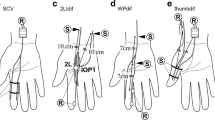Abstract
Measurement of distal motor latencies of the median nerve are often part of electrodiagnostic studies used to verify a diagnosis of peripheral neuropathy. Since electrodiagnostic studies are time consuming, expensive, and impractical for large-scale screening of at-risk individuals, a portable digital electroneurometer was developed for measuring motor latencies as a screening tool for early detection of nerve compression syndromes, including carpal tunnel syndrome. The purpose of this study was to determine the intertester and intratester reliability of a digital electroneurometer in subjects with (n=12) and without (n=20) clinical signs of carpal tunnel syndrome. This study addressed only the reliability and not the validity of this device. Using a repeated measures design, three evaluators performed two distal motor latency tests on the median nerve of each of the subjects. Pearson product-moment correlations for intratester reliability ranged from 0.94 to 0.99, and the intraclass correlation coefficient for intertester reliability was 0.96. Two examiners obtained statistically larger latency values on the second test, although these differences are judged to be clinically insignificant. Use of an electroneurometer may expand motor latency testing to a wider variety of settings.
Similar content being viewed by others
References
Bleecker ML, Agnew J. New techniques for the diagnosis of carpal tunnel syndrome.Scand J Environ Health 1987; 13: 385–388.
Braun RM, Davidson K, Doerh S. Provocative testing in the diagnosis of dynamic carpal tunnel syndrome. J Hand Surg (Am.) 1989; 14A: 195–197.
Currier DP.Elements of research in physical therapy. Baltimore: Williams and Wilkins, 1984.
Dorwart, BB. Carpal tunnel syndrome: A review.Semin Arth. Rheum 1984; 14: 134–140.
Katz, JN, Larson MG, Sabra A,et al. The carpal tunnel syndrome: Diagnostic utility of the history and physical examination findings.Ann Intern Med 1990; 112: 321–327.
Merchut MP, Kelly MA, Cone Toleikis S. Quantitative sensory thresholds in carpal tunnel syndrome.Electromyogr Clin Neurophysiol 1990; 30: 119–124.
Nathan PA, Srinvasan H, Doyle LS,et al. Location of impaired sensory conduction of the media nerve in carpal tunnel syndrome.J Hand Surg (Br) 1990; 15B: 89–92.
Phalen GS. The carpal-tunnel syndrome. Seventeen years' experience in diagnosis and treatment of six hundred fifty-four hands.J Bone Joint Surg (Am) 1966; 48: 211–228.
Redman MD, Rivner MH. False positive electrodiagnostic tests in carpal tunnel syndrome.Muscle nerve 1988; 11: 511–518.
Rosier RN, Blair WF. Preliminary clinical evaluation of the digital electroneurometer.I.S.A. Proceedings, Biomedical Sciences Instrumentation 1984; 20: 55–62.
Osterman AL, Aversa BA, Greenstein D. Use of the Nervepace Electroneurometer as an Effective Screening Tool in the Diagnosis of Carpal Tunnel Syndrome. American Society for Surgery of the Hand, 44th Annual Meeting, Seattle, Washington, Scientific Exhibit, September 1989.
Shrout PE, Fleiss JL. Intraclass correlations: Uses in assessing rater reliability.Psychol Bull 1979; 86: 420–428.
Nathan PA, Meadows KD, Doyle LS. Relationship of age and sex to sensory conduction of the median nerve at the carpel tunnel and association of slowed conduction with symptoms,Muscle Nerve 1988; 11: 1149–1153.
Cook TM. Instrumentation. In Nelson RM, Currier DP, eds.Clinical electrotherapy. Norwalk, Connecticut: Appleton & Lange, 1987, pp. 21–24.
Simpson JA. Electrical signs in the diagnosis of carpal tunnel and related syndromes.J Neurol Neurosurg Psychiat 1956; 19: 275–280.
Author information
Authors and Affiliations
Rights and permissions
About this article
Cite this article
Cook, T.M., Rosecrance, J.C., Brokman, S.J. et al. Reliability of a digital electroneurometer for the determination of motor latency of the median nerve. J Occup Rehab 1, 105–112 (1991). https://doi.org/10.1007/BF01073381
Issue Date:
DOI: https://doi.org/10.1007/BF01073381




